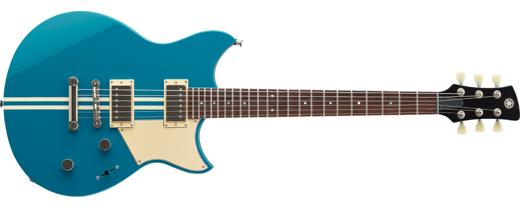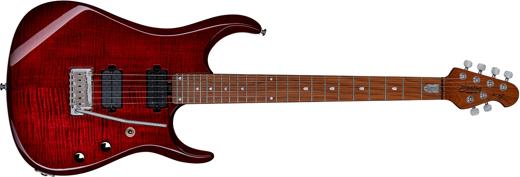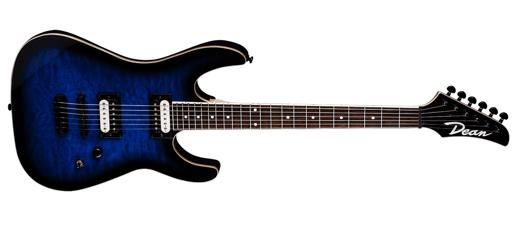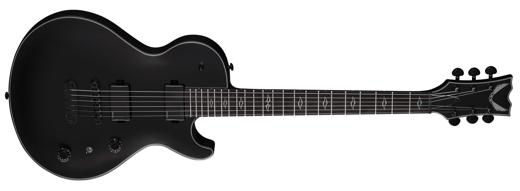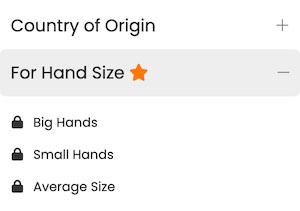Chapman ML1 Hybrid Review & Prices
- From Chapman's 2021 Standard series
- Made in Indonesia
- 6 strings
- 25.5"'' scale
- 9.5" Fretboard Radius
- Quilted Maple Veneer On Flat Top with Gloss Finish top
- Mahogany body
- Roasted Maple – Medium Colour neck
- Roasted Maple – Medium Colour fretboard
- Bridge pickup: Chapman Sonorous Zerø Humbucker (Humbucker/Passive)
- Middle pickup: Chapman Venus Witch Zerø Single Coil (Single Coil/Passive)
- Neck pickup: Chapman Venus Witch Zerø Single Coil (Single Coil/Passive)
- 1 volume and 1 tone Dome knobs
- 5-way Switch
- Chapman 2-Point Tremolo with Steel Block bridge
- C Shape Bolt-On neck
- 22 Jumbo frets
- Chapman Classic Closed (18:1 Gearing) tuners
- Compare Specs >
Our Scores and Tone Evaluation
- Heavy Metal
- Hard Rock
- Jazz
- Blues
- Funk
- Country
Chapman ML1 Hybrid
- Expensive Wood
- Ivory Tusq Nut
- Coil Split Pickups
- Tremolo
- Cheap Fret Wire (NS)
- No Locking Tuners
- Made in Indonesia
- No Top Brand Pickups
- No Neck-Through Build
- No Weight Relief
- No Luminescent Inlay
- No Compound Radius Fretboard
- No 21:1 Tuner Ratio
- No Strap Lock
Price Overview
Its average competitor's price is $750, which means that the Chapman ML1 Hybrid is around 31% cheaper than the competition. This takes into account all instruments of the same category in our database with 6 strings and Tremolo bridge that are made in Indonesia.
These are affiliate links. We may earn a fee if you purchase after clicking. These prices are prone to error. Make sure you're buying the right product after clicking on a link from our site. We are not liable if you buy the wrong product after following these links. As an Amazon Associate site we earn from qualifying purchases.
Videos





Your feedback
Not all instruments are created equally. That's why it's important to have different opinions. Here's what our users who have played this instrument say. If you've played it before, help others by voting below!
Weight
VoteTuning stability
VoteNeck speed (thickness)
VoteNeck access to high frets
VoteNeck profile shape
VoteFret edges
VotePickups noise
VotePickups power
VoteIs it Easy to Play?
The Chapman ML1 Hybrid meets 6 out of our 8 criteria items for beginner friendliness, which means that it's a good guitar to start with as a complete beginner. This takes into account the type of frets, scale length, nut width, bridge type, fretboard radius, and neck profile to determine the easiest combination for new players to get used to.
New Player Friendliness
Chapman ML1 Hybrid- Comfortable shape
- Easy-to-use bridge
- Comfortable fretboard
- Tall frets
- Narrow nut
- Comfortable neck
- Short scale
- Locking tuners
Hand Size Comfortability
After taking into account the neck profile, scale size, fretboard radius, and nut width, we can conclude that the Chapman ML1 Hybrid's construction is balanced for most hand sizes.
Nevertheless, this comes down in the end to personal preference. Make sure you test this guitar—or another one with similar characteristics—before buying.
Scale Length
Scale length is the distance the strings will span between the bridge and the nut. It can tell you a lot about the overall playability and tone of the instrument. A longer scale length means longer distance between frets, brighter tone and more string tension—which means lower action, but more difficult bending of the strings.
Here's the Chapman ML1 Hybrid's 25.5" scale length compared to other common sizes:
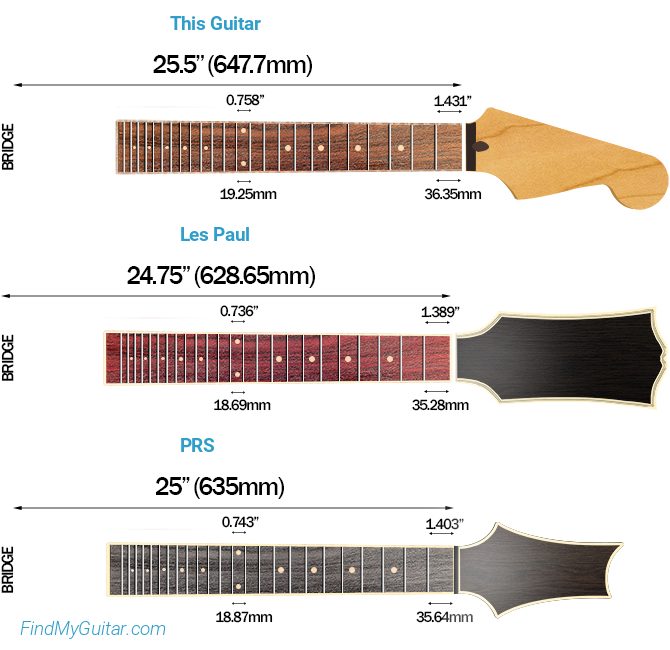
This is the same scale length used in Stratocaster guitars, and it's one of the main reasons they have such a bright sound. It's considered a long scale when compared to most non-baritone guitars.
Since the distance between bridge and nut is relatively long, you'll need to give the strings more tension to get them in tune. This higher tension will allow for a couple of things. First, you can get a lower action (get the strings closer to the fretboard) because the strings won't 'wiggle' too much when pluck and won't cause fret buzz. This can allow you to use lower tunings without increasing your string gauge, and it will make it easier to press down the strings fast.
However, the frets will also have a wider separation between each other, which can make it harder to play, especially if you got small hands. The higher tension will also make the strings feel stiffer, so bending will require more strength.
Neck Profile

The neck profile tells you the thickness (neck depth) and shape in cross section. Every difference will completely change the feeling and comfortability of the neck. This is a highly subjective thing, but most players indeed prefer certain types of necks (like Cs and Ds) because they feel nice in most hands.
The Chapman ML1 Hybrid's neck thickness is approximately 0.905'' (23mm) at the first fret, and 0.944'' (24mm) at the twelfth.
These measurements were taken either from the official Chapman website, or, in case this information wasn't provided, by researching multiple online marketplaces and forums where owners of this model have posted their measurements.
It has a C type neck. C-shaped necks like this have been the most popular for the last years. The reason is that they feel good in most hands. It's generally a thin neck that doesn't get in your way when playing fast, but that also has enough mass to give your hands a comfortable grip for chords if they aren't too big.
Thin necks like this make it easier to move your hand across the neck and it helps when playing fast solos, especially if you like to leave your thumb free while playing high on the fretboard. However, thinner necks are also weaker and will need adjustment more often than a thicker neck.
Fretboard Radius
When it comes to fingerboard radius, personal preference will dictate which one is better for you. However, most people seem to agree that a more curved (lower) radius will make it easier to play chords while a less curved (higher) radius is better for soloing and bending.
The Chapman ML1 Hybrid has a 9.5" fingerboard radius.
Here's an image comparing this fretboard radius to other popular choices:

This is the most common radius for Stratocaster guitars. It's considered curved when compared to most other models. This allows you to play chords very easily without muting strings accidentally and gives you more space between strings for fingerpicking. However, this curve also gives the guitar less allowance for lower action. If you bend too hard at the high frets, some of your notes might get muted because the curve will make the string fret out.
Compound radius fingerboards give the best of both worlds. Unfortunately, the Chapman ML1 Hybrid has the same radius across the board.
Playability compared to main competitors
Nut Width
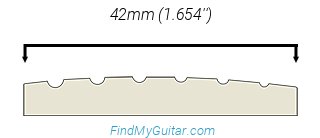
The Chapman ML1 Hybrid has a nut width of 42mm (1.654''). This is considered a narrow width for a 6-string guitar. This means that this guitar will have a narrower string separation at the nut, which will affect your fretting hand.
If you are a player with big hands, you might find it difficult to play chords without muting strings. However, this is good for players who have smaller hands, as it will allow them to reach each string more easily at the nut.
Frets
The Chapman ML1 Hybrid has 22 frets. Even though 24 frets has become really popular, there's still a good reason to get fewer frets; the pickup at the neck position will be further away from the bridge. This makes the neck pickup achieve a warmer tone. You might want this if you're playing Jazz or similar genres.
However, if you don't care about the warmer neck pickup, more frets will always be better. It's always nice to have the option to play higher notes if you want to.
It comes with nickel silver frets, so they won't last as long as stainless steel frets. If you use your instrument a lot, you might need to replace the frets after a few years. But this is unlikely as most people change instruments before this happens.
Fret Size

Finally, let's talk about fret size. Some people prefer tall frets because it's easier to press the strings and perform bends since there's less friction against the fretboard. On the other hand, some people like shorter frets because they like to touch the fretboard when playing, or because they got heavy hands and tend to press too much on the string and alter the of the note pitch accidently.
The Chapman ML1 Hybrid's frets are Jumbo size. This is a tall fret size that is becoming increasingly popular because it makes it easier to press down the strings cleanly. With this fret size, you won't feel the fretboard when playing, so if you press down too hard, you will get the notes out of pitch. However, this is something you can overcome by getting used to the taller size.
Playability Score
Tone Analysis
Wood will have little influence in the final tone of an electric guitar or bass. Instead, the hardware, especially the pickups, will be the most important thing to look at. Bur first, let's see the quality of the wood.
Wood


Mahogany Body: This is the type of wood found in many top-of-the-line guitars, so that's a positive point for the build quality. This red-looking wood Mahogany is found in Africa and Central America and has great sustain and a warm tone due to its high density. The downside about this type of wood is that it's relatively heavy.
Roasted Maple Neck and Fretboard: Similar to simple Maple, but even stronger, darker, and more stable to temperature changes. This is thanks to the treatment process that consists in using high temperatures to drain the water, sugar, and resins from the wood.
Pickups
Unfortunately, it doesn't come with pickups from one of the top brands. This doesn't mean you will get bad pickups, but you might want to consider a pickup upgrade after some time.
These are passive pickups, so you can expect a rounder sound and a moderade level of output.
The Chapman ML1 Hybrid's configuration is HSS. If you play a lot with humbuckers in the bridge position, but would also love to have pristine cleans, this is a great configuration to have. The bridge humbucker will give you tons of output for playing distorted rhythm parts, while the single coils will give you a lot of tone options.
More with the same pickups
Versatility
It gives you a good amount of tone options with its 5-way switch. You can use it to choose at least 5 different pickup combinations.
It has a Coil Split option. It allows you to 'split' or turn off pickup coils to get even more tones in combination with the pickup selector. When used with humbucker pickups, it'll reduce the output and increase their clarity, turning them essentially into single-coil pickups.
Diagram

What music genre is it good for?
As a 6 strings, Solid Body guitar with HSS configuration and Passive pickups, we'd recommend it for genres like Hard Rock or similar. However, you can use almost any guitar for any genre. This is just the typical type of music for this particular one.
Sound Score
Build Quality Analysis
Country of Origin
Knowing where the instrument is produced is a good way to know how well it's built. Some manufacturing countries are known for having higher quality standards. For example, most expensive instruments are made in the US or Japan, but there are some exceptionally great countries—like South Korea—that are building a good reputation.
The Chapman ML1 Hybrid is made in Indonesia. Many people prefer the quality of an Indonesian guitar over a Chinese. Respectable brands like Epiphone, Ibanez and Schecter are building in this country because of the great quality and lower price. Some people like to compare them to the ones built in Japan during the 80s, when Japanese guitar makers made a name for themselves.
Bridge
Chapman 2-Point Tremolo with Steel Block: This type of bridge allows you to change the pitch of the notes by pulling the bridge with the attached bar, which gives you better versatility. Also, since the bridge is not fixed to the guitar body, the bridge will move as you bend the strings. So you'll have to increase the distance of your bends to reach the same tension (note) compared to a fixed bridge. This allows you to perform smoother bends but will also make you slower. Finally, remember that this type of bridge requires a bit more maintenance than fixed ones, especially when changing strings.
Tuners
The tuners have a ratio of 18:1. This means you need 18 turns of the tuner knob to make the tuner post go around 1 complete revolution. The more turns it takes, the finer and more precise your tuning is going to be. An 18:1 ratio is what most instruments have nowadays. Some high-end ones come with a ratio of 21:1.
Nut Material
Another important thing to analyze is the nut material, as it's one of the most important aspects that can affect the sound and playability of your guitar. A well-cut nut will make sure it stays in tune and will make it more comfortable to play.
In this case, the Chapman ML1 Hybrid has a Ivory Tusq nut. This material is made to look, feel and sound like Ivory. It's made of organic polymers and doesn't contain oil or animal products. This is probably the highest quality nut you can get, so you can expect good tune stability and more clear tones when playing open strings. Most people seem to agree that it looks nicer than any plastic and even some bone nuts.
Neck Joint
The neck joint is the part where the neck of the guitar meets the body. There are three main techniques to attach both parts together: Set-In, Bolt-On and Neck-Through. The latter two provide different advantages, although neck-throughs are the most expensive.
This guitar has a Bolt-On neck joint. Even though this type of neck was looked down upon for a long time, nowadays bolt-on necks are well built and provide just as much sustain as any other join method. First of all, it's cheap to make because it consists of simply 4 bolts that attach the neck to the body. And you can travel with the guitar more easily, swap out the neck if you damage it, or upgrade to a more comfortable neck later on.
Build Quality Score
All Specs
Chapman ML1 HybridUser Reviews
Help others by sharing your opinion about this guitar. Note: to avoid spam, your review will be submitted for approval before appearing here.
